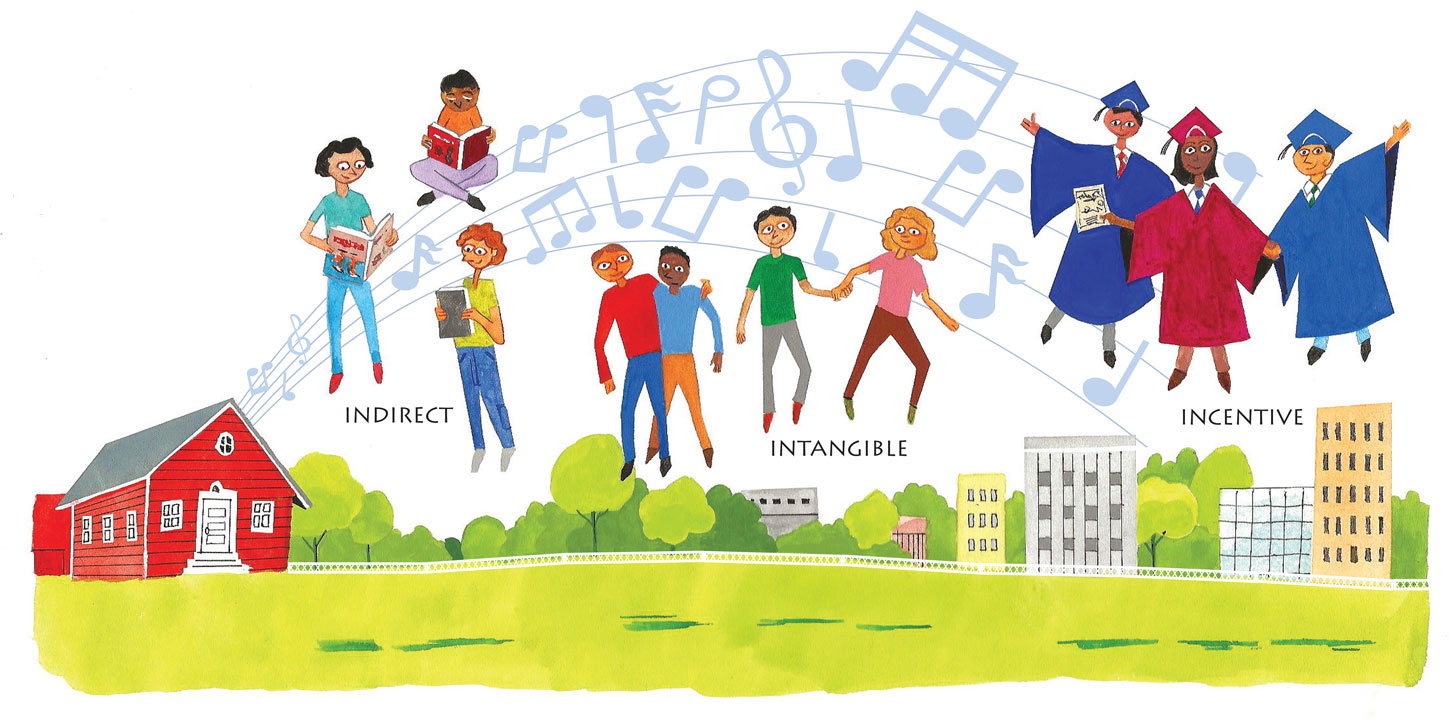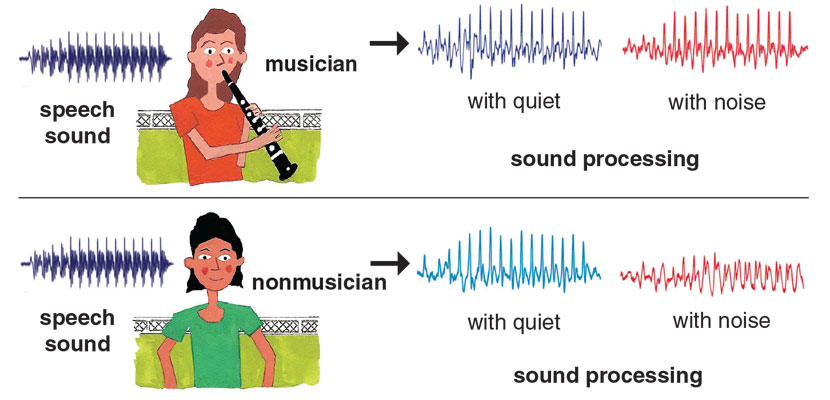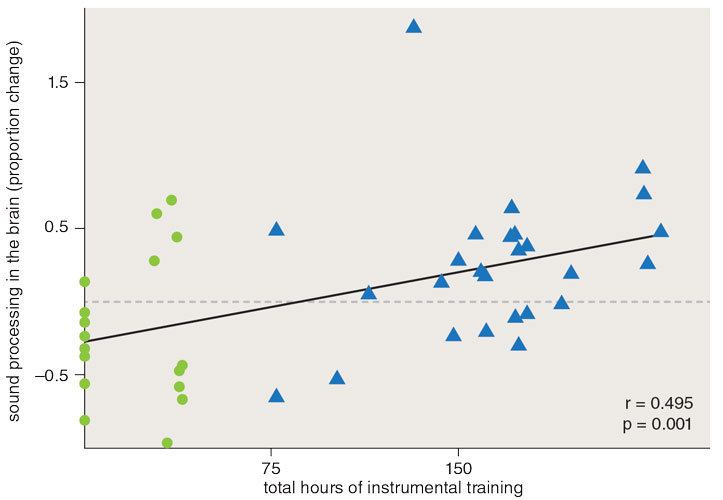The Argument for Music Education
By Nina Kraus, Travis White-Schwoch
Musicians’ brains show striking benefits.
Musicians’ brains show striking benefits.

Margaret Martin needed help. It was early 2011 and had been 10 years since she’d founded Harmony Project, which provides free music lessons to children from underserved Los Angeles neighborhoods. Martin made a simple deal with each student who enrolled: If you maintained passing grades, and if you attended every practice and performance at Harmony Project, you would have a guaranteed spot for free until you graduated high school. Demand for her program quickly outstripped the number of available openings, and Martin grew desperate to shrink the waiting list.
Harmony Project kept growing in popularity partly because its students excelled in not only music but also many seemingly unrelated areas: They graduated at the top of their classes, earned college scholarships, and went on to successful careers. Martin had touted those success stories as she tirelessly grew her project, but now she needed school districts and large foundations to invest larger sums in Harmony Project. She knew from her training in public health how to develop experimental data to convince policy makers.

Tom Dunne
Martin saw that music was sparking something in her students’ brains that was setting them up for academic success, but she didn’t have the evidence to prove it. She realized she needed the help of a neuroscientist.
The notion that the brain is malleable—a trait that we now call neuroplasticity—dates back more than a century to the earliest days of neuroscience. Spanish neuroscientist Santiago Ramón y Cajal, who is remembered today chiefly for his drawings of brain cells (see “Neuroscience as Neuroart” on our Science Culture blog), also discovered that cellular projections wax and wane throughout an organism’s life, a phenomenon he poetically termed neural gymnastics. He intuited that the nervous system is dynamic.
But rigorously documenting and studying these plastic changes in the brain remained out of reach for decades. In the 1970s and 1980s, when tracking the activity of a single neuron became possible, scientists finally could prove that learning was rooted in changes to a neuron’s physiology—basically, its proclivity to spark a jolt of electricity, sending signals to other neurons.
For more than 30 years, we have studied neuroplasticity in humans. Our work has focused on determining how to measure the integrity of sound processing in the brain using electrophysiology—measuring brain waves from the scalp. Although measuring the jolt of electricity from a single neuron is impossible in humans, we could measure the aggregate electrical activity emanating from the brain. Around the time that Martin started Harmony Project, we had embarked on a complementary line of research: studying musicians as a model for neuroplasticity to understand the neural mechanisms at work in the kinds of changes Martin saw in her students.
Musicians dedicate their lives to focused, disciplined, and repeated practice. Moreover, playing music offers an unlimited capacity for improvement: Musicians constantly strive for nuance, defter technique, and better synchrony with their ensembles. Articles implying a link between musicianship and brain plasticity started to appear: Violinists had enlarged motor brain areas dedicated to the hand; expert musicians made finer judgments about sounds that differed subtly in timing or pitch.
We suspected something more might be going on with music. Playing music could affect more than our ability to process melodies and rhythms; it might trigger much broader cognitive and sensory changes. With our colleagues Gabriella Musacchia, Erika Skoe, Patrick Wong, and Mikko Sams, our lab decided to investigate. We recruited a cohort of college students, half of whom had been avid musicians for several years and the other half were musically naive. We then measured electrophysiological responses to speech and music—brain waves that tell us the integrity of sound processing in the brain.
In a pair of papers published in 2007, we reported that the musicians had heightened responses to the subtle acoustic details of speech, suggesting that music training generalizes to language. Indeed, the musicians’ brains could encode acoustic details of Mandarin speech too subtle for most English speakers to detect, suggesting that music training might enable a listener to be a more precocious language learner.
These initial findings caught the attention of a pair of conservatory-trained classical musicians turned neuroscientists, Alexandra Parbery-Clark and Dana Strait, who came to our lab to pursue their doctorates. With their combined forces, we could test for effects of music training across the entire lifespan. We assembled a group of test subjects, split them into age groups, and for each, identified age-appropriate tests of brain function, hearing abilities, and cognition.
Musical experience early in life imparts lifelong neuroplasticity.
We quickly discovered that music training forges a remarkably similar brain signature across all ages. Musicians’ brains more quickly and accurately encode certain ingredients of speech sounds than do those of nonmusicians. Music training improves the brain’s ability to process speech sounds against a noisy background, such as the din of a busy restaurant. This neural resilience made sense, because musicians also had a superior ability to understand speech in a noisy environment. Moreover, they had stronger memory and attentional skills than did nonmusicians. Although there were developmental variations, with certain aspects of brain function being fine-tuned later in life than others, music training seemed to have a strikingly consistent effect across the lifespan.
Some of the most surprising results came from musicians in their sixties and seventies, who showed stronger memory, attention, and hearing abilities than did contemporaries who had never participated in music training. We also found direct evidence for differences in brain function between older musicians and nonmusicians. Neural responses to speech generally slow as we age. Not so in lifelong musicians: A 65-year-old musician’s neural responses are indistinguishable from those of a 25-year-old nonmusician. The responses of a 65-year-old who played music as a child but hadn’t touched an instrument in decades fell in the middle: faster than those of a peer who had never played music but slower than those of a lifelong musician. Musical experience early in life imparts lifelong neuroplasticity.
A skeptic might reasonably look at our comparisons between musicians and nonmusicians and argue that the ostensible benefits of music training—sharper hearing, augmented cognitive abilities, and heightened auditory brain functions—were predispositions that influenced individuals to seek music training. We were therefore eager to conduct a formal experimental trial of music training.
Traditional trials in medicine allow high levels of control so that researchers can make rigorous causal conclusions. In a randomized-control trial to test a drug’s efficacy, for example, researchers can recruit a large cohort, randomize them to receive a specified dose of the drug or a placebo for a circumscribed time, and measure a defined endpoint.
That’s easier said than done for music. One can’t condense music instruction into pill form. We were never enthusiastic about relying on simulacra of music instruction, such as two weeks of basic recorder training in a lab. We both know from personal experience that’s not how anyone learns to play an instrument.
Around this time Martin serendipitously found her way to our lab with her thriving, real-world instrumental music program available for study. In the summer of 2011 four of our colleagues flew to Los Angeles to test for two weeks 75 school-aged kids eager to enroll in Harmony Project. They performed an intensive battery of tests, inspired by our earlier work, determining hearing abilities, memory, attention, language, and, crucially, the neural responses to speech. A camper that looked like it had been used for location shoots on Miami Vice became an ad hoc lab outside Harmony Project’s office.
We designed the research project so that half of the kids would immediately begin instrumental music lessons and the other half would wait one year, during which time they would participate in classes on basic music note reading, music history, and related topics. After collecting the baseline data, our team returned to Chicago, and we waited for one of the longest years of our careers. Someone on our team frequently called Harmony Project to make sure the students in our study were still enrolled. Every time a family moved away from Los Angeles over the study period it felt like a gut punch.

Tom Dunne
The next July our team flew back to Los Angeles to repeat the tests, swapping the camper for instrument closets. After returning to Chicago they immediately began systematically analyzing the data. As expected, there were no discernible changes in cognition, language, or brain function among the children who completed the music appreciation class. Then we analyzed the group who received music lessons and found . . . nothing. If the music lessons had sparked neuroplasticity, we could not find a scintilla of evidence.
It was an awkward phone call to Martin. Her response? Come back next year. So our team repeated the study in July 2013. This time, however, the data told a different story (see figure below). The instrumental group’s brain responses and language and listening skills had advanced above those of their peers in a way completely consistent with our initial studies. It was as if their brains had suddenly matured by leaps and bounds.
In 2014 we published the initial results of the Harmony study in the Journal of Neuroscience. It was one of the first studies of community-based music programs to document neurological outcomes and, to our knowledge, the first to focus on children from underserved areas.
A parallel study in our lab reinforced our findings. While half our lab members made their annual trip to Los Angeles, our colleague Jennifer Krizman took the other half to the Chicago Public Schools to test nearly 150 high school students. Half began music training their freshman year, and the other half participated in a drill team. She and her team published their results in 2015 in the Proceedings of the National Academy of Sciences of the U.S.A. Once again music training enhanced neural processing of speech sounds and accelerated auditory brain development after two years. Comparing music training to the drill team also showed it wasn’t extracurricular enrichment in general that sped up brain development. It was music.
Since then, other scientists have performed similar studies with community music groups. Each experiment showed that music lessons accelerate brain development, but only after some time. The papers were the missing arrows in Martin’s quiver. They have helped her gain support to expand Harmony into a national program serving more than 1,000 kids annually with free music lessons.
Our research into music and neuroplasticity has given us opportunities such as speaking to teachers, policy makers, and the media, which are relatively rare for scientists. Like other scientists who have studied music and brain development, we strongly support music classes in schools and community music organizations that provide cocurricular or extracurricular music education.
When we find ourselves talking about brain development and language tests as outcomes of music education, however, a thought sometimes nags us. Why do we have to justify music lessons in the first place?
We see the arguments for teaching music in schools taking three general forms, which we call the indirect argument, the incentive argument, and the intangible argument.
The indirect argument posits that music boosts brain and cognitive function that is important for learning. In turn, these heightened skills facilitate success in school. School administrators and policy makers should invest in music education because it equips students to fare better in their courses. Children and adults with music training, for example, have a superior ability to understand speech in noisy environments, such as some classrooms.
We believe the indirect argument has the strongest empirical support and lends itself to controlled studies. Children can enroll in music classes, and researchers can follow them empirically, as in our studies. It is the core gist of our work: Music training sets up children’s brains to make them better learners by enhancing both sound processing in the brain and cognition. But the types of benefits associated with the indirect argument are a step removed from school administrators’ mandated academic benchmarks, such as standardized-test scores.

Figure adapted from Kraus et al., 2014
This limitation leads us to the incentive argument, which directly ties the benefits of music education to educational outcomes such as standardized testing, attrition, grade point average, college matriculation, and even health outcomes. The incentive argument is the one that Martin makes when she cites Harmony Project’s graduation rate. It is similar to the indirect argument, and the underlying mechanisms may well be the same—but the incentive argument bypasses the mediating benefits to the brain and goes right to metrics that, rightly or wrongly, our society values when measuring schools. These outcome measures also lend themselves to large-scale research studies in economics and public health, which we anticipate will be of growing interest.
The incentive argument is easy for administrators and educators to use to justify music in schools. Education policy in the United States has created strong incentives for teachers and administrators to care deeply about these outcomes—particularly standardized tests (notwithstanding the intrinsic problems with those tests themselves). Still, it’s a pity that such an abstract, far-removed, and imperfect metric must justify music education.
We think that some of the most profound neurodevelopmental benefits of music manifest in ways that are difficult to quantify in robust research studies, leading us to the intangible argument, which proposes that the deepest benefits of music education are challenging to reduce to a set of data points and parameters. Such benefits include the focus and discipline that come from years of regular practice, the social engagement and satisfaction that grow when making music in an ensemble, the friendship that results from staying twice a week after school for a rehearsal, and the confidence that develops from performing alone on a stage. For us, the intangible argument rings true as likely the most accurate description of how music education benefits children. What made Harmony Project an exciting opportunity is that it provided real-world music training, which is too complicated to reduce to discrete data points. Our view is that music education supports child development in its most holistic sense.

Annie Tritt
At the same time, we realize the intangible argument is the most difficult one to make. We believe the tools of science are an imperfect aperture to address certain questions. Paradoxically, every layer of control added to experiments with music training can obscure the intangibles that make music music. But just because something cannot be measured doesn’t mean we should ignore it.
After evaluating the preponderance of the evidence, we are confident that music education should be part of every child’s curriculum. Music education manifestly supports child development in ways both easy and difficult to measure. Augmented sound processing in the brain makes young musicians better learners, which can generalize to benchmarks such as standardized tests and grades that society values in education.
If the goal of public education is to equip children to be productive members of society, then the intangible argument makes the most vital points about the importance of music education. As Leonard Bernstein once said, music “can name the unnameable and communicate the unknowable.”
Click "American Scientist" to access home page
American Scientist Comments and Discussion
To discuss our articles or comment on them, please share them and tag American Scientist on social media platforms. Here are links to our profiles on Twitter, Facebook, and LinkedIn.
If we re-share your post, we will moderate comments/discussion following our comments policy.